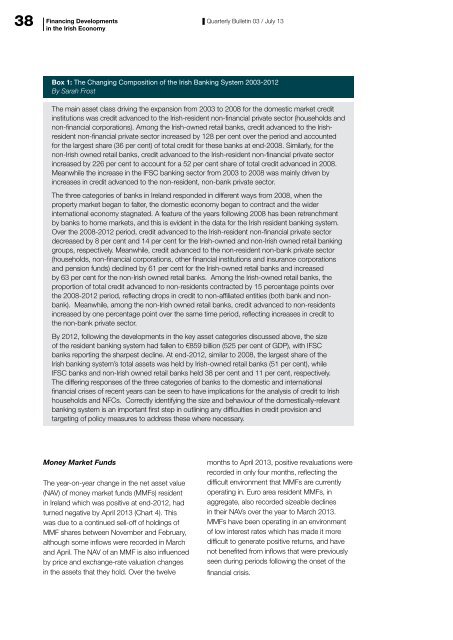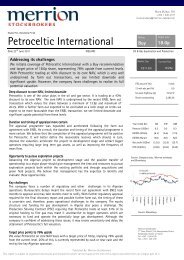Quarterly Bulletin Q3 2013
Quarterly Bulletin Q3 2013
Quarterly Bulletin Q3 2013
Create successful ePaper yourself
Turn your PDF publications into a flip-book with our unique Google optimized e-Paper software.
38<br />
Financing Developments<br />
<strong>Quarterly</strong> <strong>Bulletin</strong> 03 / July 13<br />
in the Irish Economy<br />
Box 1: The Changing Composition of the Irish Banking System 2003-2012<br />
By Sarah Frost<br />
The main asset class driving the expansion from 2003 to 2008 for the domestic market credit<br />
institutions was credit advanced to the Irish-resident non-financial private sector (households and<br />
non-financial corporations). Among the Irish-owned retail banks, credit advanced to the Irishresident<br />
non-financial private sector increased by 128 per cent over the period and accounted<br />
for the largest share (36 per cent) of total credit for these banks at end-2008. Similarly, for the<br />
non-Irish owned retail banks, credit advanced to the Irish-resident non-financial private sector<br />
increased by 226 per cent to account for a 52 per cent share of total credit advanced in 2008.<br />
Meanwhile the increase in the IFSC banking sector from 2003 to 2008 was mainly driven by<br />
increases in credit advanced to the non-resident, non-bank private sector.<br />
The three categories of banks in Ireland responded in different ways from 2008, when the<br />
property market began to falter, the domestic economy began to contract and the wider<br />
international economy stagnated. A feature of the years following 2008 has been retrenchment<br />
by banks to home markets, and this is evident in the data for the Irish resident banking system.<br />
Over the 2008-2012 period, credit advanced to the Irish-resident non-financial private sector<br />
decreased by 8 per cent and 14 per cent for the Irish-owned and non-Irish owned retail banking<br />
groups, respectively. Meanwhile, credit advanced to the non-resident non-bank private sector<br />
(households, non-financial corporations, other financial institutions and insurance corporations<br />
and pension funds) declined by 61 per cent for the Irish-owned retail banks and increased<br />
by 63 per cent for the non-Irish owned retail banks. Among the Irish-owned retail banks, the<br />
proportion of total credit advanced to non-residents contracted by 15 percentage points over<br />
the 2008-2012 period, reflecting drops in credit to non-affiliated entities (both bank and nonbank).<br />
Meanwhile, among the non-Irish owned retail banks, credit advanced to non-residents<br />
increased by one percentage point over the same time period, reflecting increases in credit to<br />
the non-bank private sector.<br />
By 2012, following the developments in the key asset categories discussed above, the size<br />
of the resident banking system had fallen to €859 billion (525 per cent of GDP), with IFSC<br />
banks reporting the sharpest decline. At end-2012, similar to 2008, the largest share of the<br />
Irish banking system’s total assets was held by Irish-owned retail banks (51 per cent), while<br />
IFSC banks and non-Irish owned retail banks held 38 per cent and 11 per cent, respectively.<br />
The differing responses of the three categories of banks to the domestic and international<br />
financial crises of recent years can be seen to have implications for the analysis of credit to Irish<br />
households and NFCs. Correctly identifying the size and behaviour of the domestically-relevant<br />
banking system is an important first step in outlining any difficulties in credit provision and<br />
targeting of policy measures to address these where necessary.<br />
Money Market Funds<br />
The year-on-year change in the net asset value<br />
(NAV) of money market funds (MMFs) resident<br />
in Ireland which was positive at end-2012, had<br />
turned negative by April <strong>2013</strong> (Chart 4). This<br />
was due to a continued sell-off of holdings of<br />
MMF shares between November and February,<br />
although some inflows were recorded in March<br />
and April. The NAV of an MMF is also influenced<br />
by price and exchange-rate valuation changes<br />
in the assets that they hold. Over the twelve<br />
months to April <strong>2013</strong>, positive revaluations were<br />
recorded in only four months, reflecting the<br />
difficult environment that MMFs are currently<br />
operating in. Euro area resident MMFs, in<br />
aggregate, also recorded sizeable declines<br />
in their NAVs over the year to March <strong>2013</strong>.<br />
MMFs have been operating in an environment<br />
of low interest rates which has made it more<br />
difficult to generate positive returns, and have<br />
not benefited from inflows that were previously<br />
seen during periods following the onset of the<br />
financial crisis.




